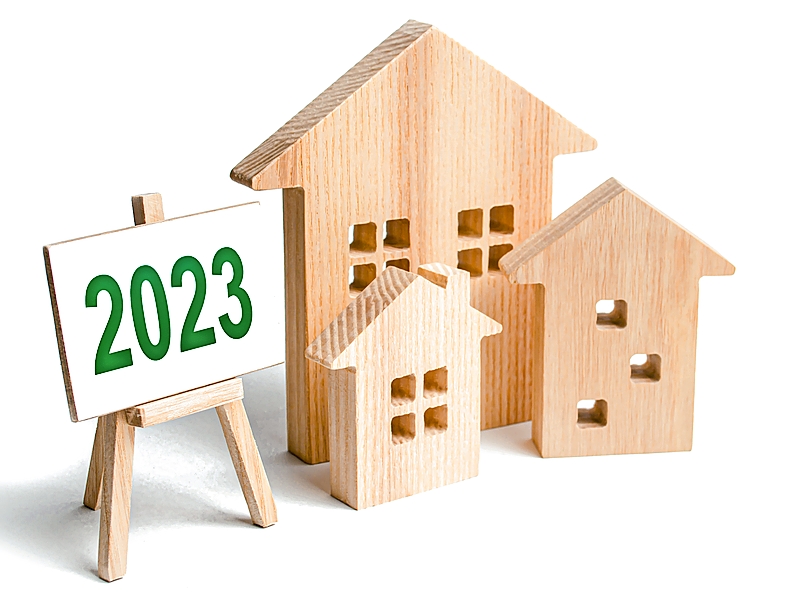What a Ride
By Mark Loehrke
March 2023 View more Featured
Projections for the 2023 real estate market

It’s cliché at this point to refer to the real estate market as a roller-coaster ride. Given the frequent (and extreme) ups and downs in home prices and sales over the past several years, it’s more fitting to describe a roller coaster as something of a real estate ride. But considering the near certainty that the track ahead will continue its now-familiar pattern of dips and climbs as we progress deeper into 2023, here are a few things to keep in mind about how we got here—and how to buckle up for the months ahead.

Where We’ve Been
It’s no secret the pandemic led to a supercharged real estate market over the past several years, as many people gained a newfound desire to upgrade their home surroundings, which suddenly served as not just a place to lay one’s head at night but also the center of their work and social lives. As a result of these and other factors, home prices soared, and listings became mere formalities, with many properties being snapped up the minute they appeared. But the second half of 2022 saw rumbles in the broader economy that brought a chill to the red-hot housing market—both nationally and locally.

“Rising interest rates have cooled demand for housing and also reduced consumer buying power,” says Geoff Smith, executive director of the Institute of Housing Studies at DePaul University. “Based on our review of data, this has led to a slowdown in sales activity, but prices have remained more stable. Broadly speaking, inventory remains fairly tight compared to demand, even if demand has cooled.”
Overall, the market has shifted as interest rates have risen, causing some buyers to bow out.
“Some dropped out because of multiple-offer fatigue, but the shift has also caused the market to normalize a little bit, with not as many multiple-offer situations; buyers no longer have to write an ‘as is’ offer,” explains Penny O’Brien, a Baird & Warner agent working in the western suburbs. “In addition, market time is increasing a bit, making it easier for a buyer to buy. That said, an amazing, updated home is still selling the first weekend, while a more dated home in original condition is starting to accumulate market time. And there is still historically low inventory, which means the sellers’ market continues.”

Where We’re Headed
Both Smith and O’Brien believe that even amid a rising-rate environment, limited inventory will continue to support home prices as 2023 progresses. However, those higher rates and the lower supply of available properties may portend a number of other issues throughout the market.

“There are concerns that limited for-sale housing supply will continue to be a factor in the coming years,” Smith says. “Since 2019 many households either purchased their home or refinanced their mortgages to take advantage of record low interest rates. Because interest rates have quickly increased, these homeowners may be locked-in to their low monthly housing payments—which means they may be reluctant to sell their homes and take on a new mortgage with much higher monthly payments. While there are many homeowners who don’t have a mortgage and new construction or rehabbed homes that will hit the market in coming years, it will be interesting to see how this interest rate lock-in affects the for-sale housing supply. If inventory remains tight and interest rates remain relatively high, I think affordability could continue to be a concern.”
Indeed, it’s even a possible deal-breaker for some buyers. “The rise in interest rates has affected the lower-price-point buyers’ purchasing power more than the higher-price-point buyers, as they can no longer afford the higher monthly payment,” O’Brien says. “Beyond that, we need inventory to be released to create movement—buyers are waiting on the sidelines to pounce. Updated homes, priced correctly, are going to sell in multiple offers. It’s important to remember that there’s always a market and people always need to move.”
Where’s the Inventory?
Based on late-December 2022 MLS data from Infosparks, the northern Illinois region had a 1.7-month supply of single-family homes available, while a cluster of eight west suburban communities (including Naperville and surrounding areas) had just a 1.08-month supply. Similarly, the northern Illinois region had 3.7-month supply of townhouses, while the western burbs had only a 0.93-month supply.
Changing Mindsets
O’Brien believes too many sellers tend to get stuck in the groove of the previous year’s market, while buyers are more likely to quickly pick up on and adjust to any changes. As price appreciation begins to normalize throughout 2023, she cautions sellers not to overprice their homes—even as low inventory means the sellers’ market marches on. “Buyers are under the impression that prices are going down and therefore won’t be keen on overpaying,” she says.
Photos courtesy of Katherin Frankovic (Penny O’Brien), DePaul University (Geoff Smith), and istock


